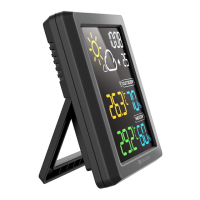
Do you have a question about the Digoo DG-8647 and is the answer not in the manual?
| Type | Weather Station |
|---|---|
| Model | DG-8647 |
| Display Type | LCD |
| Indoor Humidity Range | 20% to 95% |
| Outdoor Humidity Range | 20% to 95% |
| Wireless Transmission Frequency | 433 MHz |
| Indoor Temperature Range | 0°C to 50°C (32°F to 122°F) |
| Outdoor Temperature Range | -20°C to 60°C (-4°F to 140°F) |
| Power Source | Batteries |
| Features | Calendar, Time, Alarm |
| Wireless Transmission Range | 100 meters |
Overview of the display unit's features including weather forecast icons, time, alarm, outdoor signal strength, and temperature/humidity displays.
Overview of the outdoor sensor's features including integrated hang hole and battery compartment.
Recommendations for battery usage, avoiding mixing old/new or different types, and using lithium batteries for outdoor sensors in cold conditions.
Details on the device's default time, weather forecast, temperature unit, and alarm settings upon initial use or reset.
Instructions for using the MODE button to enter setting mode, switch between time and alarm display.
Usage of the UP button for increasing settings, fast adjustment, viewing MAX/MIN data, and clearing MAX/MIN records.
Usage of the DOWN button for decreasing settings, fast adjustment, switching temperature units, and clearing data/searching RF.
Operation of the SNZ/LIGHT button to activate snooze function or control the backlight.
Step-by-step guide for manually setting the hour and minute using the MODE, UP, and DOWN buttons.
Procedure for setting the alarm time, turning it on/off, and understanding the snooze function for alarms.
Specifies the operational ranges and display behavior for indoor and outdoor temperature and humidity measurements.
Details the accuracy specifications for both temperature and humidity measurements under different conditions.
Instructions on how to switch between Celsius and Fahrenheit units using the DOWN button.
Guide on how to view and clear the maximum and minimum recorded temperature and humidity values.
Information on how to control the display backlight brightness when powered by the USB line.
Explanation of the low battery indicator and the importance of immediate battery replacement.
Description of the icons used for weather forecasting and their accuracy limitations.
Guidelines for optimal placement of the display unit to ensure accurate measurements and performance.
Recommendations for placing the outdoor sensor outside for accurate weather observation, considering shade and airflow.
